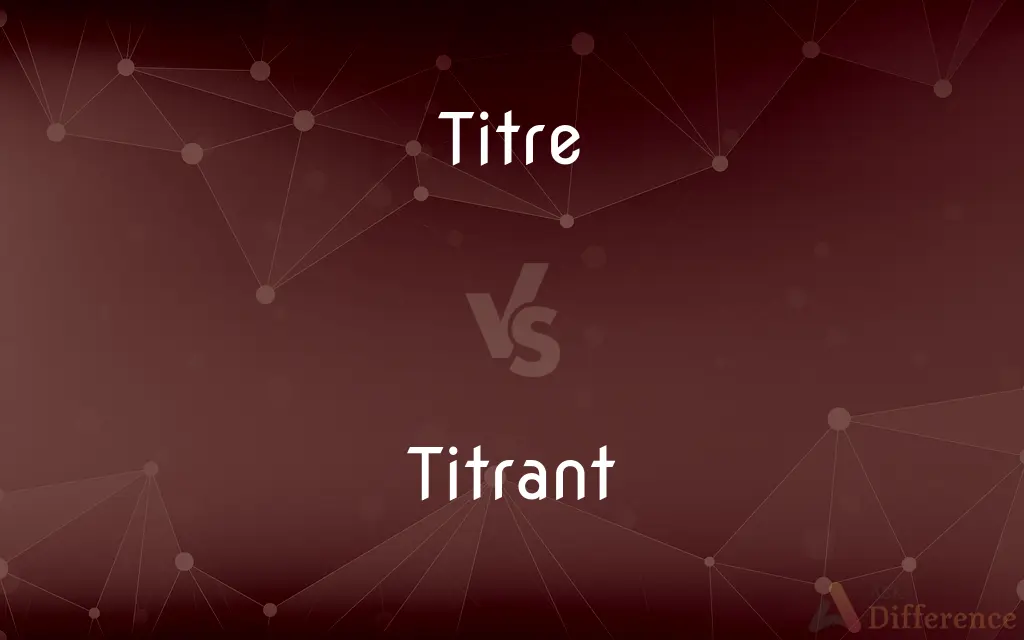Titre vs. Titrant — What's the Difference?
By Tayyaba Rehman & Urooj Arif — Updated on April 7, 2024
Titre measures the concentration of a solution in volumetric analysis, while titrant is the solution of known concentration used to determine the unknown concentration.

Difference Between Titre and Titrant
Table of Contents
ADVERTISEMENT
Key Differences
Titre is a term used in chemistry, specifically in volumetric analysis, to denote the concentration of a solution that has been determined through titration. In this process, the exact volume of one solution (titrant) that reacts exactly with a known volume of another solution allows the determination of the latter's concentration. Whereas titrant refers to the solution with a known concentration that is added to another substance to determine the unknown concentration. This known solution is usually standardized and its volume is carefully measured during the titration process.
In the context of a titration experiment, the titre value is the result of careful calculation after the experiment has been conducted. It reflects the potency or concentration of the substance being analyzed. On the other hand, the titrant is selected based on its reactivity with the substance under investigation. The choice of titrant is crucial for the accuracy and feasibility of the titration.
Titre can vary depending on the substance being titrated and the conditions under which the titration is performed, such as temperature and pH. Meanwhile, titrants are often strong acids or bases that show a clear and sharp endpoint in the titration curve, facilitating precise determination of the equivalence point.
The process of determining the titre involves several steps, including the titrant's addition to the analyte, until the end point of the reaction is reached. This contrasts with the preparation of the titrant, which requires accurate measurement and sometimes standardization against a primary standard.
Understanding the difference between titre and titrant is fundamental for students and professionals in chemistry, as it underpins the quantitative analysis of solutions. While the titre is an outcome of the titration process, the titrant is a key component that drives the chemical reaction to completion.
ADVERTISEMENT
Comparison Chart
Definition
Concentration of a solution determined by titration.
Solution of known concentration used in titration.
Role in Titration
End result indicating substance concentration.
Active agent used to react with the analyte.
Preparation
Calculated post-titration based on titrant volume.
Prepared and standardized before titration.
Selection Criteria
Determined by the analyte and titration type.
Chosen for known reactivity with the analyte.
Importance in Analysis
Reflects the quantitative measure of analyte.
Essential for determining the unknown concentration.
Compare with Definitions
Titre
The concentration of a substance in a solution as determined by titration.
The titre of the vinegar was found to be 0.1 M acetic acid.
Titrant
The reagent added to the analyte in titration.
A carefully measured volume of titrant was added dropwise.
Titre
The volume of titrant required to reach the endpoint of the titration.
The titre value was 25 mL, indicating the concentration of the sodium hydroxide solution.
Titrant
The basis for calculating the concentration of an unknown.
The amount of titrant used was crucial for accurate calculations.
Titre
The endpoint volume in volumetric analysis.
The titre was carefully recorded for the lab report.
Titrant
A solution of known concentration used in titration.
The sodium hydroxide solution was used as the titrant in the acid-base titration.
Titre
A measure of the strength or concentration of an analyte.
The experiment's outcome provided the exact titre of the unknown solution.
Titrant
The active substance in the titration process.
The titrant reacted completely at the equivalence point.
Titre
The result of a titration analysis.
After calculation, the titre revealed the purity of the substance.
Titrant
A standardized solution for determining unknown concentrations.
The titrant was standardized using potassium hydrogen phthalate.
Titre
Variant of titer.
Titrant
A substance, such as a solution, of known concentration used in titration.
Titre
(analytical chemistry) The strength or concentration of a solution that has been determined by titration.
Titrant
(analytical chemistry) The reagent of known concentration and volume used in titrations.
Titre
To determine a titre, especially by titration
Titre
The concentration of a solution as determined by titration
Common Curiosities
Why is the choice of titrant important?
The choice of titrant is crucial for the accuracy of the titration, as it must react in a predictable and measurable way with the analyte.
How is the titre value determined?
The titre value is determined by calculating the concentration of an analyte based on the volume of titrant required to reach the endpoint of a titration.
What factors influence the selection of a titrant?
Factors include the chemical nature of the analyte, the type of titration, and the desired precision and accuracy of the results.
What is the importance of the titre in analysis?
The titre provides a quantitative measure of the concentration of the analyte, essential for chemical analysis and quality control.
What role does the titre play in volumetric analysis?
The titre serves as the key outcome of volumetric analysis, indicating the exact concentration of the analyte in the solution.
What is a titrant?
Titrant is a solution with a known concentration used to determine the concentration of an unknown solution by titration.
How is the endpoint of a titration determined?
The endpoint is typically indicated by a color change or an electrical measurement, signaling that the reaction between the titrant and analyte is complete.
Is the titre always a volume measure?
While often related to volume, the titre more accurately reflects the concentration derived from the volume of titrant used.
What is titre?
Titre refers to the concentration of a solution determined through the process of titration.
Can the titrant and titre be the same for different titrations?
While the titrant can be used in various titrations, the titre value is specific to each particular analysis and depends on the analyte and titrant used.
Can titrations be performed without a standardized titrant?
While possible, titrations without a standardized titrant are less accurate, as the concentration of the titrant is crucial for calculating the unknown concentration.
How do you standardize a titrant?
Standardization involves reacting the titrant with a known amount of a primary standard substance and calculating the exact concentration.
What types of titrations use titrants?
All forms of titration, including acid-base, redox, and complexometric titrations, use titrants.
How does temperature affect the titre?
Temperature can influence the reaction rate and equilibrium, potentially affecting the titre by altering the endpoint of the titration.
What is the difference between the endpoint and equivalence point in titration?
The endpoint is the observable indication that the reaction is complete, while the equivalence point is the exact moment when the quantities of titrant and analyte are stoichiometrically equivalent.
Share Your Discovery

Previous Comparison
Losing vs. Loosing
Next Comparison
Knife vs. KniveAuthor Spotlight
Written by
Tayyaba RehmanTayyaba Rehman is a distinguished writer, currently serving as a primary contributor to askdifference.com. As a researcher in semantics and etymology, Tayyaba's passion for the complexity of languages and their distinctions has found a perfect home on the platform. Tayyaba delves into the intricacies of language, distinguishing between commonly confused words and phrases, thereby providing clarity for readers worldwide.
Co-written by
Urooj ArifUrooj is a skilled content writer at Ask Difference, known for her exceptional ability to simplify complex topics into engaging and informative content. With a passion for research and a flair for clear, concise writing, she consistently delivers articles that resonate with our diverse audience.














































